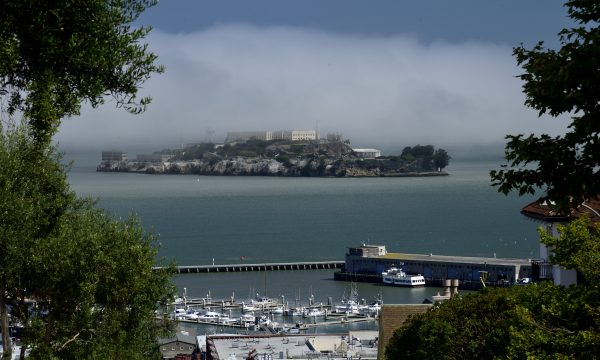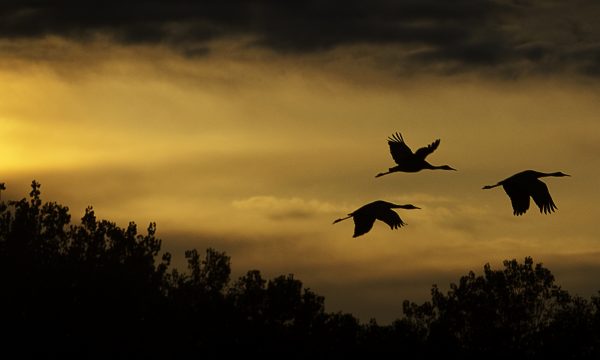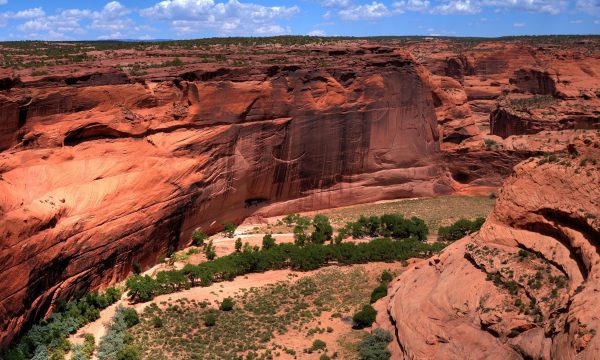Watch out! Here you have good chance to smooch a wolf! This is truly an experience of a very special kind – playing with wolves, kissing, cuddling and hugging, and if you want to, even “dancing with wolves” like Kevin Costner! Not possible? Well, it is, in the Colorado Wolf and Wildlife Center.
Darlene Kobobel has created something, only few will succeed in: she built up the Colorado Wolf and Wildlife Center, which is now home to canine predators that live here in a natural reserve with forests, lush aspen, large rock formations and hills, offering them privacy, security and stimulation.
The Center currently houses 18 wolves, two coyotes and eight foxes. You will be enchanted by Zaltana’s intense look, enjoy the playful antics of gorgeous Nakai and experience the romantic story of the joyful couple Chinook and Nikita; the latter two even have a monument dedicated to them at the Center.
Introducing some of the residents you encounter at the Center: There are the two polar wolves Akela and Makah Behr; the two Mexican gray wolves Cero and Rio; 11 Timber wolves, all with very different personalities, such as the almost black, proud Zaltana; the playful Na’vi; the shy Keara; or the beautiful wunderkind Nakai, who survived a malicious bone disease and “worked” as a model for so many postcards and pictures, which can be purchased at the visitor center.
The regular tour lasts about one hour and takes you through the whole site of the Center. During the tour, you will learn about the biography of the individual wolves, foxes and coyotes living in the Center. Other topics to be addressed are e.g. pack hierarchy, territorial claims, communication within the pack and prey impact. It is not that you wander from one exhibit or enclosure to the next, no; you will get a real insight into animal life and behavior.
Each tour ends with a special farewell, “the wolf howl”. The tour guide starts howling, and you will be asked to join in, and sure enough all wolves will complete the concert; a great experience for everyone.
Anyone wanting to experience something special, something unique, something you will not have a chance for every day, it is recommended to take the VIP tour or the photo tour. Both tours cost a little more, but the wolves benefit from these extra funds for the Center.
The VIP tours are scheduled directly after the end of the regular tour, so you will have about 30 minutes / half an hour at the so-called Ambassador enclosure, where you will get up close with some of the wolves. No need to worry, these are all gentle and docile, very playful and as mentioned, kisses are not uncommon. Do not forget your camera! For this tour you should wear solid shoes and be dressed appropriately. You can play with the wolves, run around, and if you feel like it, even roll on the ground. What an experience!
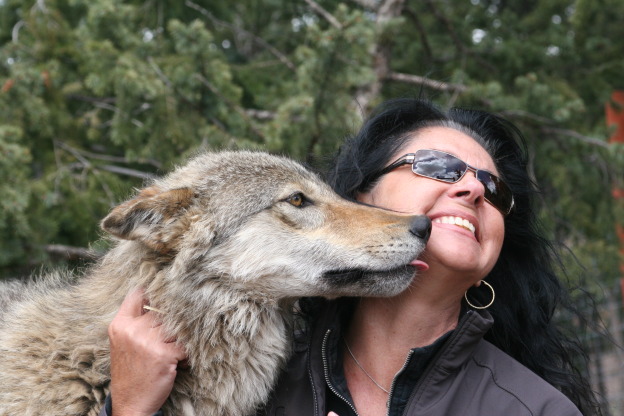
The photo tour will be accompanied by a photographer from the Colorado Wolf and Wildlife Center; he will take some photos of you and the wolves, up close and personal. You will get about 15 high resolution digital pictures on a CD, so they can be enlarged accordingly. Understandably, this tour is weather dependent.
Both tours, VIP and photo, are subject to certain terms and conditions, which you can find on the Center’s website.
It all began in 1993 when Darlene rescued a wolfhound named Chinook from being put down. As Darlene learned about the fate of this beautiful animal, she took Chinook home and began to research about the challenges and controversies of wolfhounds and wolfhound breeders throughout the county of Teller, just two hours south of Denver, Colorado. And, as already mentioned, despite her fear of wolves, she was determined to provide a safe haven for unwanted wolfhounds and opened Wolf Hybrid Rescue Center. In the first year, the center was flooded with 15-20 phone calls daily; People from all over the States wanted to give their beloved wolves to Darlene, so she recognized the need for information and education about wolves, especially for those who thought a wolf was a nice pet, or others, as herself, who shared an unknown fear about wolves.
The animals at the Colorado Wolf & Wildlife Center are indeed beautiful. After almost ten years of rescuing animals either turned in or left for good by their owners, it was time for relocation. The plan was to focus more on informing and educating society. Darlene and her volunteers realized that it would be impossible – from the physical aspect as well as from the financial one – to save each and every animal that needed to be saved. Putting the focus more on education would allow the Wolf Center to save more animals. Darlene’s dream to convert the Wolf Hybrid Rescue Center into the Colorado Wolf & Wildlife Center began to take shape. However, there was a huge setback, as Darlene’s plans were threatened by the devastating Hayman fire of June 2002.
Shortly before, Darlene had found a private ranch that she could lease on a long term contract. The ink had not yet dried when suddenly the Hayman fire broke out. Within only three hours’ time, Darlene and her crew not only had to evacuate all the wolves but also the domestic cats, dogs, horses and even a chicken. An empty horse stable on another ranch was the temporary home for the wolves for five weeks; the pets could be accommodated with friends and relatives. The fire burned over four weeks and destroyed more than 138,000 acres, i.e. almost 560 square kilometers.
The sudden and unexpected evacuation forced the team to accelerate the construction and development of the Colorado Wolf & Wildlife Center. Alone the fencing of the new sanctuary devoured $25,000 of the money set aside for veterinary costs and the step-by-step construction of the center. Thanks to the energetic and hard work of countless volunteers six wolf enclosures with about 43,000 square feet each (4000 square meters) could be erected within five weekends. The release of the wolves into their new home was a very emotional moment, for humans and animals.
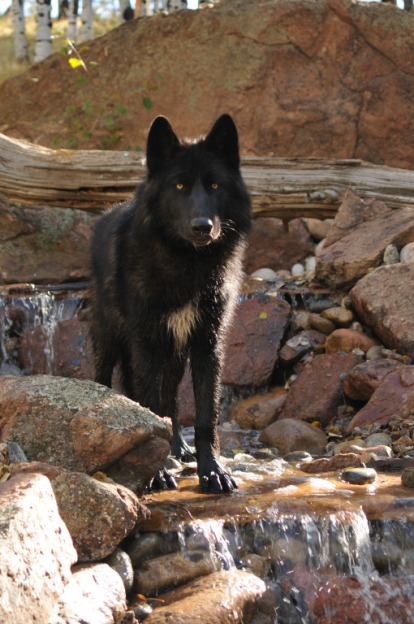

In June 2003, the official inauguration of the Colorado Wolf & Wildlife Center was celebrated. Yet another setback was luring around the corner, as after only three and a half years, the lease for the Center was suddenly terminated. Besides this, Darlene had to cope with the passing away of her beloved Chinook, the first wolfhound she had saved about ten years ago. After a frantic search Darlene found another fantastic site and yet again began the construction of the present-day Colorado Wolf & Wildlife Center with some volunteers. Next to the enclosures for the animals, there is also a visitor center and a residential building with conference and educational facilities. The final inauguration was conducted in September 2007.
The Colorado Wolf and Wildlife Center is a non-profit organization and does survive solely on donations and revenue coming in from the different tours offered. In March 2008, the Center received the Association of Zoos and Aquariums (AZA) certification. This represents one of the highest and most prestigious recognition to be awarded to a zoo or an aquarium, let alone to an animal sanctuary. The Colorado Wolf & Wildlife Center is the only one of its kind in Colorado and one of only 20 in the whole country honored by this award. Due to this certification, the Center is now also allowed to accommodate animals from the list of endangered species, such as the two Mexican gray wolves, originating from the Cheyenne Mountain zoo in Colorado Springs or the four swift foxes from the Pueblo zoo.
The Colorado Wolf and Wildlife Center offers guided educational tours and programs that focus on overcoming the myths about wolves and other wild animals, hence making the visitors understand the role of wolves in the ecosystem.
Although some of the animals were rescued from dormitories, traveling zoos, farms and the fur industry, the Center also has simply adopted some of the animals.
Learning the background of wild animals forces the visitors to recognize appreciation and respect as well as realize that “wild really means wild”!
To find under: Reisen & Abenteuer, Colorado
——————————————————————————————————————————————–
This article was published in issue 02/2011 of Spirit of the West Magazine
——————————————————————————————————————————————–



